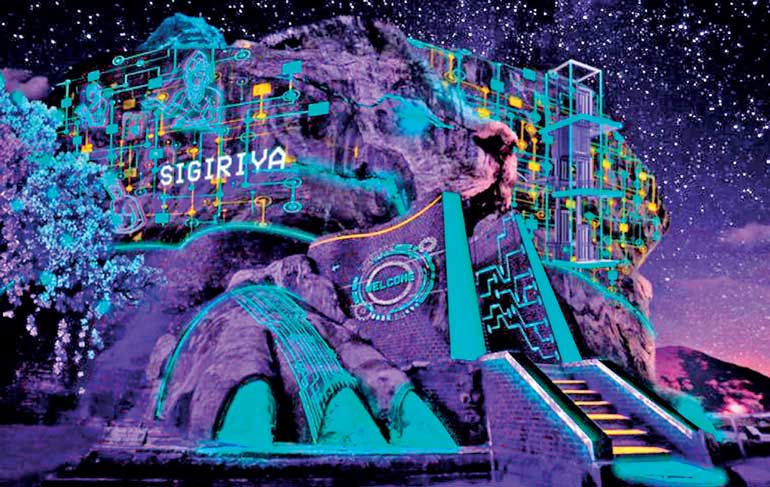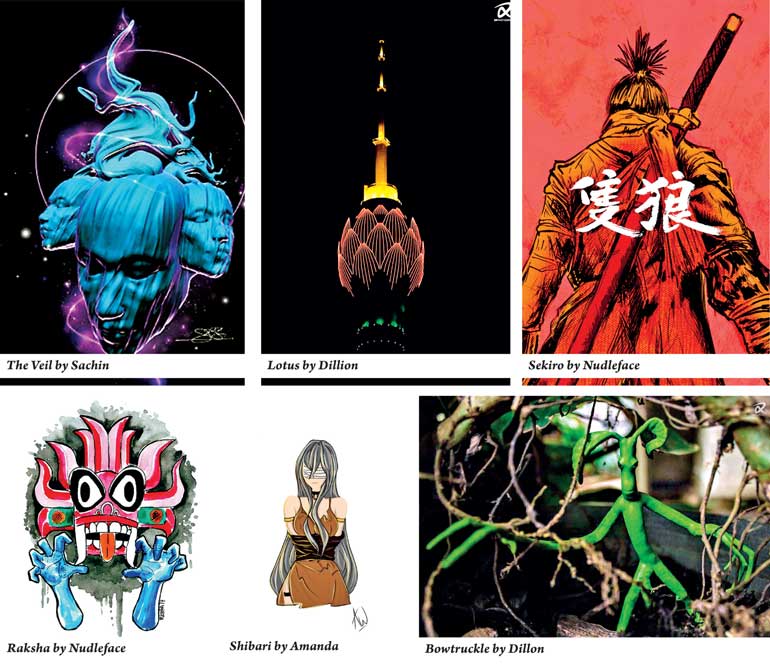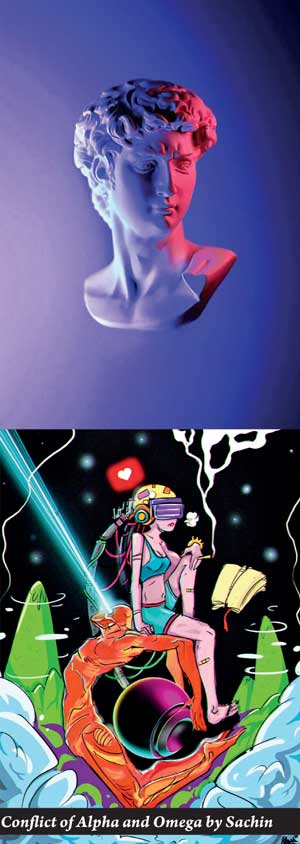Wednesday Dec 31, 2025
Wednesday Dec 31, 2025
Saturday, 17 July 2021 00:05 - - {{hitsCtrl.values.hits}}

Sigiriya, 2077 by Deluge of Ash
 In May 2014, Anil Dash and Kevin McCoy created what they called monetised graphics, which Dash describes as a blockchain-backed means of asserting ownership over an original digital work. This was presented at the Seven on Seven conference held at the New Museum of Contemporary Art in New York City.
In May 2014, Anil Dash and Kevin McCoy created what they called monetised graphics, which Dash describes as a blockchain-backed means of asserting ownership over an original digital work. This was presented at the Seven on Seven conference held at the New Museum of Contemporary Art in New York City.
The technology developed over the years and is now known as non-fungible tokens or NFTs. On social media, a large number of conversations around NFTs have been taking place this year, but not many are aware of the technology as well as what it is exactly.
While significant growth can be seen in the market, with Bloomberg in March calling it a billion-dollar market, Sri Lanka’s first NFT auction, organised by Urban.lk, was held on 12 and 13 June, with the main artwork selling for $1,275.
According to Urban, Sigiriya, 2077 had a winning bid of $1,275, Raksha had a winning bid of $203, Lotus had a winning bid of $150, David had a winning big of $110, Bowtruckle had a winning bid of $55, Sekiro had a winning bid of $55, The Veil had a winning bid of $53, Conflict of Alpha and Omega had a winning bid of $53, and Shibari had a winning bid of $50.
Given how new a technology NFT is to Sri Lanka, Urban.lk Director Operations Kalana Muthumuni spoke to Daily FT about non-fungible tokens, what it would mean to local artists, and the country’s first NFT auction.
Following are excerpts:
By Shailendree Wickrama Adittiya
Q: The conversation on NFTs is quite recent. What exactly is an NFT?
A: NFT stands for Non-Fungible Tokens. An NFT is a unit of data stored on a digital ledger, called a blockchain, that certifies a digital asset to be unique and therefore not interchangeable. For instance, if you and I each have one bitcoin and you exchange it with my bitcoin, at the end of the transaction, the net change is zero. But you cannot interchange NFTs. It will be like trying to interchange a Van Gogh with a 2B pencil. This is the non-fungibility.
NFTs can really be anything digital (such as drawings, music, your brain downloaded and turned into an AI), but a lot of the current excitement is around using the tech to sell digital art. NFTs are now being used to commodify digital assets in art, music, sports, and other popular entertainment. Most NFTs are part of the Ethereum blockchain; however, other blockchains can implement their own versions of NFTs.
Q: Why are NFTs so popular?
A: NFTs have been taking the market by storm, with some NFTs auctioning at exorbitant values such as $ 69 million. The popularity comes from the discovery of a new and exciting technology that can disrupt both art and tech worlds alike. The importance of NFTs lies in providing the ability to securely value, purchase and exchange digital art using a digital ledger. NFTs are best understood as computer files combined with proof of ownership and authenticity, like a digital deed. Furthermore, we are really excited about the repetitive royalty functionality of NFT. That means the original artist keeps getting a commission, even after they no longer own the NFT. This is revolutionary.

Q:How will NFTs benefit artists as well as collectors?
A: With features such as repetitive royalty, artists are able to benefit from their work continuously. Collectors are able to protect and verify artwork thanks to the blockchain ledger which will be able to track the origin and the sale record of the product.
Q:Is it only artwork that is considered an NFT or are other items used as well?
A: NFT-use cases are constantly being explored. They can be used to represent virtually any type of real or tangible item. Not limiting to art, but even tokenised real world assets, virtual items in video games, music, collectibles like trading cards, virtual lands and video footage.
 Q:What are some concerns that one may have about NFTs, especially concerning the authenticity of artwork?
Q:What are some concerns that one may have about NFTs, especially concerning the authenticity of artwork?
A: When you purchase an NFT, you need to go through a verified seller/platform. Usually the artists endorse the auction platform and you can purchase through that. That’s the best way to avoid buying a counterfeit NFT. But within a platform, you will not find replicas.
Q: Urban.lk held Sri Lanka’s first NFT auction. Tell us about it.
A: We launched our gallery section early this year. It is a space where local artists can commercialise their work easily. Given the popularity and immense benefits that NFT bring to artists, we wanted to connect them with the NFT market.
Urban hosted Sri Lanka’s first NFT Auction on 12 and 13 June and brought a value of over $ 2,000 to up and coming artists from Sri Lanka. The headliner of the auction, Sigiriya 2077 by Adaash Lanthra, received close to 50% of the total bids and auctioned at $1,275.
The auction was live for 24 hours starting from 6 p.m. on 12 June and saw a lot of engagement from the community. The final bid for the headliner Sigiriya 2077 came at the last second, topping the previous bid.
Nine artworks were sold in total from artists Ranmith Welikala, Amanda Weerasinghe, Rakitha Senevirathne, Dillon De Silva and Sachin Raveena, with many people from investment funds to startup founders to cryptocurrency enthusiasts engaging and winning bids.
NFT is taking the world by storm, allowing artists to create a ‘digital deed’ for their digital art. This is the first step in Urban’s mission to introduce Sri Lankan artists to the NFT market and help them go global. Later this year, Urban will be launching a fully-fledged NFT platform to the global market. This will allow the creation and trading of NFTs on the platform.
A portion of Urban’s profits from the auction is donated towards the charity Colombo Taprobane Roundtable 3, for their program ‘Kids off the streets’.
Given the overwhelming response, Urban will host a few more auctions like this before the NFT platform is launched.
Q:How does the auction work?
A: You can go to nft.urban.lk and create/login to your account. You can pay $ 5 and register to bid on an artwork. This is refunded immediately after the auction is finalised. When you pay that once, you do not need to pay it to increase your bid. The person who placed the winning bid can then make the payment by logging into their account. The NFT token will be transferred directly to the winner.
Q: What was the response from both artists and bidders?
A: It has been amazing. A large number of people have been signing up for the auction, ready to bid. And many local artists have contacted us to join our upcoming platform. With this platform, we will help local artists access a global market.
Q:How do you think NFT auctions will help local artists?
A: NFT auction is the preliminary step in connecting local artists with the NFT market. In October, we will be coming up with our own NFT auction platform where an artist can sign up, create and sell NFTs based on their digital work. This will be a gateway for them to be discovered by a global market. And what’s more, once the NFT token is sold, it will continue to generate money for the artists through commissions.
Q: In terms of art work, how will they change the way we perceive or value art?
A: Firstly, this opens up the art world to the world of cryptocurrency. There’s a large number of individuals who are in possession of cryptocurrency, but only a limited number of vendors accept it as a payment at the moment. So this opens up a whole new market for them. This is one of the main reasons why some NFTs have been selling for millions of dollars.
Secondly, there are a very large number of artists who have engagement on social media, but get nothing out of their work. NFT is an ideal solution to such artists as well.